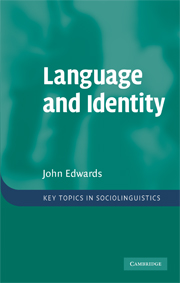Book contents
- Frontmatter
- Contents
- 1 Introduction
- 2 Identity, the individual and the group
- 3 Identifying ourselves
- 4 Language, dialect and identity
- 5 Dialect and identity: beyond standard and nonstandard
- 6 Language, religion and identity
- 7 Language, gender and identity
- 8 Ethnicity and nationalism
- 9 Assessments of nationalism
- 10 Language and nationalism
- 11 Language planning and language ecology
- Glossary
- Notes
- References
- Index
1 - Introduction
Published online by Cambridge University Press: 05 June 2012
- Frontmatter
- Contents
- 1 Introduction
- 2 Identity, the individual and the group
- 3 Identifying ourselves
- 4 Language, dialect and identity
- 5 Dialect and identity: beyond standard and nonstandard
- 6 Language, religion and identity
- 7 Language, gender and identity
- 8 Ethnicity and nationalism
- 9 Assessments of nationalism
- 10 Language and nationalism
- 11 Language planning and language ecology
- Glossary
- Notes
- References
- Index
Summary
AN INTRODUCTORY NOTE
In an earlier book in this series, Spolsky (2004) began by observing that studies of the social life of language are often too ‘language-centred’. Any investigation of language that considers only language will be deficient, and inappropriate limitations and restrictions can cripple insights. This is not a problem for this area alone, of course, but it is especially significant in a context where the hope of application fuels much of the effort. Nonetheless, any cursory examination of, say, the language-planning literature or work in the social psychology of language will quickly reveal an undesirable narrowness of perspective. Studies of ‘endangered languages’ and ‘language revival’ seem particularly prone to tunnel vision, to the curious notion that these phenomena can be understood and then ameliorated in more or less isolated fashion. Except in the conceits of ‘pure’ linguistics, no analysis of language can rationally proceed from a ‘stand-alone’ perspective. Spolsky writes that
while many scholars are now beginning to recognize the interaction of economic and political and other factors with language, it is easy and tempting to ignore them when we concentrate on language matters.
(pp. ix–x)In fact, while one still reads too many disembodied, decontextualised and, therefore, essentially useless studies, the observation here is not quite accurate. For some writers – more nowadays than in the past, I would guess – ‘temptation’ is not an apt term at all, for the simple reason that a more extensive purview seems simply beyond them.
- Type
- Chapter
- Information
- Language and IdentityAn introduction, pp. 1 - 14Publisher: Cambridge University PressPrint publication year: 2009
- 12
- Cited by

